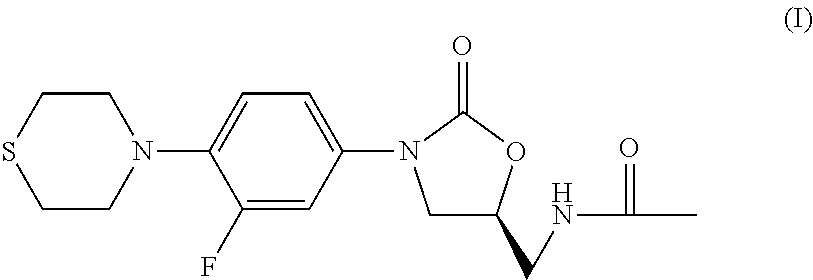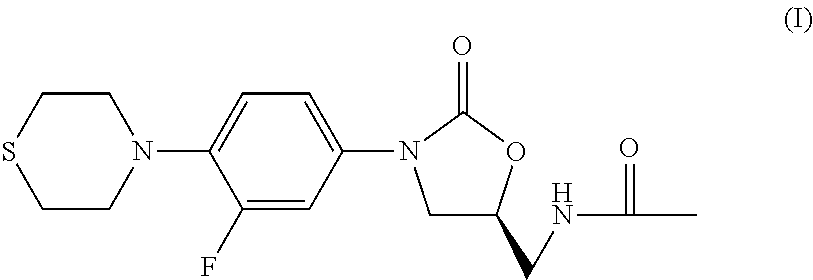Combination therapy for tuberculosis
a tuberculosis and conjugation therapy technology, applied in the field of tuberculosis treatment methods, can solve the problems of poor compliance with the relatively long treatment course, unpleasant side effects, and inability to always achieve the effect of conjugation therapy, and achieve the effect of preventing recurrence of mycobacterium infection
- Summary
- Abstract
- Description
- Claims
- Application Information
AI Technical Summary
Benefits of technology
Problems solved by technology
Method used
Image
Examples
example 1
Preparation of (S)-1-chloro-3-[(4-chloro-E-benzylidene)-amino]-propan-2-ol
Method A
[0246]A 5L three neck round bottom flask equipped with a mechanical stirrer, thermocouple, reflux condenser and heating mantle is charged with 4-chlorobenzaldehyde (351.0 g, 2.5 mol, 1.0 eq.). MTBE (1.5 L) is then charged into the round bottom to give a homogeneous solution. Aqueous ammonia (28 wt %, 252.98 mL, 3.75 mol, 1.5 eq.) is added in a single portion resulting in a white precipitate that turned into a thin slurry within 15 minutes of stirring. (S)-(+)-epichlorohydrin (>99% ee, 196.0 mL, 2.5 mol, 1.0 eq.) is then slowly charged into the vessel. After 40 minutes, the contents are then slowly heated to 43° C. The reaction is stirred at 40° C. for 18 hours at which time 8.4% area of epichorohydrin remained by GC. Upon cooling, the reaction mixture is transferred to a separatory funnel and the layers are separated. The lower aqueous layer is discarded. The organic layer is transferred to a 3 L round...
example 2
Preparation of (3-fluoro-4-morpholin-4-yl-phenyl)-carbamic Acid Benzyl Ester
[0249]The title compound can be prepared according to the method described in J. Med. Chem., 1996, 39, (3), 680-685 and depicted in SCHEME II.
[0250]Additional methods for the conversion of intermediate A to 3-fluoro-4-thiomorpholin-4-ylaniline (B) are provided.
Method A
[0251]4-(2-Fluoro-4-nitrophenyl)thiomorpholine (A, 250 g, 1.03 mole) was charged into a mixture of dioxane (1400 mL), EtOH (1000 mL) and water (600 mL) in a 5000 mL three neck round bottom flask equipped with a mechanical stirrer. Into the stirred mixture was charged ammonium chloride (166 g, 3.1 moles) followed by iron powder (247 g, 4.25 moles), each in single portions. The reaction was warmed to reflux with vigorous stirring. The reaction was heated at reflux for a total of 16 hours and was then allowed to cool to room temperature. The dark mixture was diluted with EtOAc (800 mL), filtered through a pad of celite, and concentrated in vacuo t...
example 3
Preparation of (5S)-5-{[(4-chlorobenzylidene)amino]methyl}-3-(3-fluoro-4-thiomorpholin-4-ylphenyl)-1,3-oxazolidin-2-one
[0253]The title compound in Example 2 (194 g, 0.56 mole), and the title compound of Example 1 (195 g, 0.84 mole), and lithium tert-butoxide (116 g, 1.4 mole) were charged into a 3000 mL three neck round bottom flask under nitrogen. The reactants were slurried with methyl tert-butyl ether (1200 mL) and the mixture was warmed to 56° C. and stirred for 2 h as a yellow solid gradually formed. The reaction was cooled to room temperature, and diluted with 1200 mL water. The mixture was then stirred vigorously over 60 min as the solid changed from dark yellow to a more pale yellow solid. The mixture was cooled to 10° C., filtered, and the filter cake was washed with ice cold methyl tent-butyl ether (450 mL). The resulting light yellow solid was dried in air for 30 min, then placed in a vacuum oven and dried at 40° C. overnight to afford the title compound (243 g, 99% yield...
PUM
 Login to View More
Login to View More Abstract
Description
Claims
Application Information
 Login to View More
Login to View More - R&D
- Intellectual Property
- Life Sciences
- Materials
- Tech Scout
- Unparalleled Data Quality
- Higher Quality Content
- 60% Fewer Hallucinations
Browse by: Latest US Patents, China's latest patents, Technical Efficacy Thesaurus, Application Domain, Technology Topic, Popular Technical Reports.
© 2025 PatSnap. All rights reserved.Legal|Privacy policy|Modern Slavery Act Transparency Statement|Sitemap|About US| Contact US: help@patsnap.com



